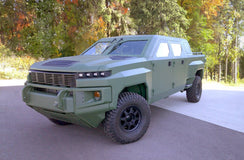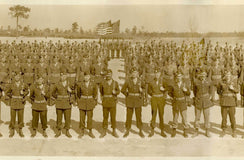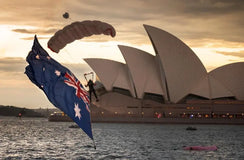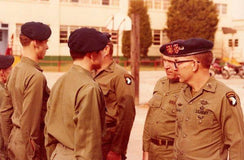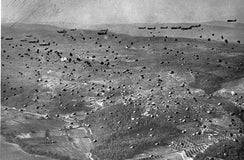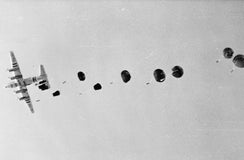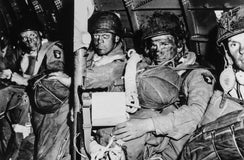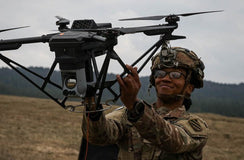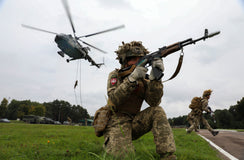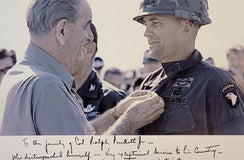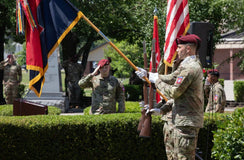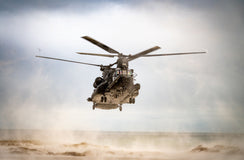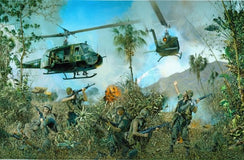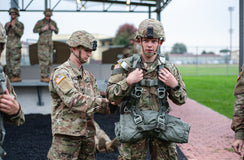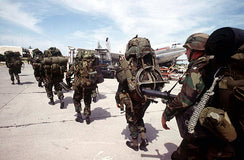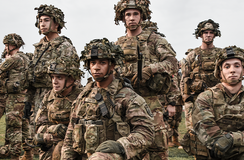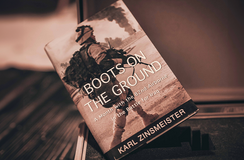The First Jump
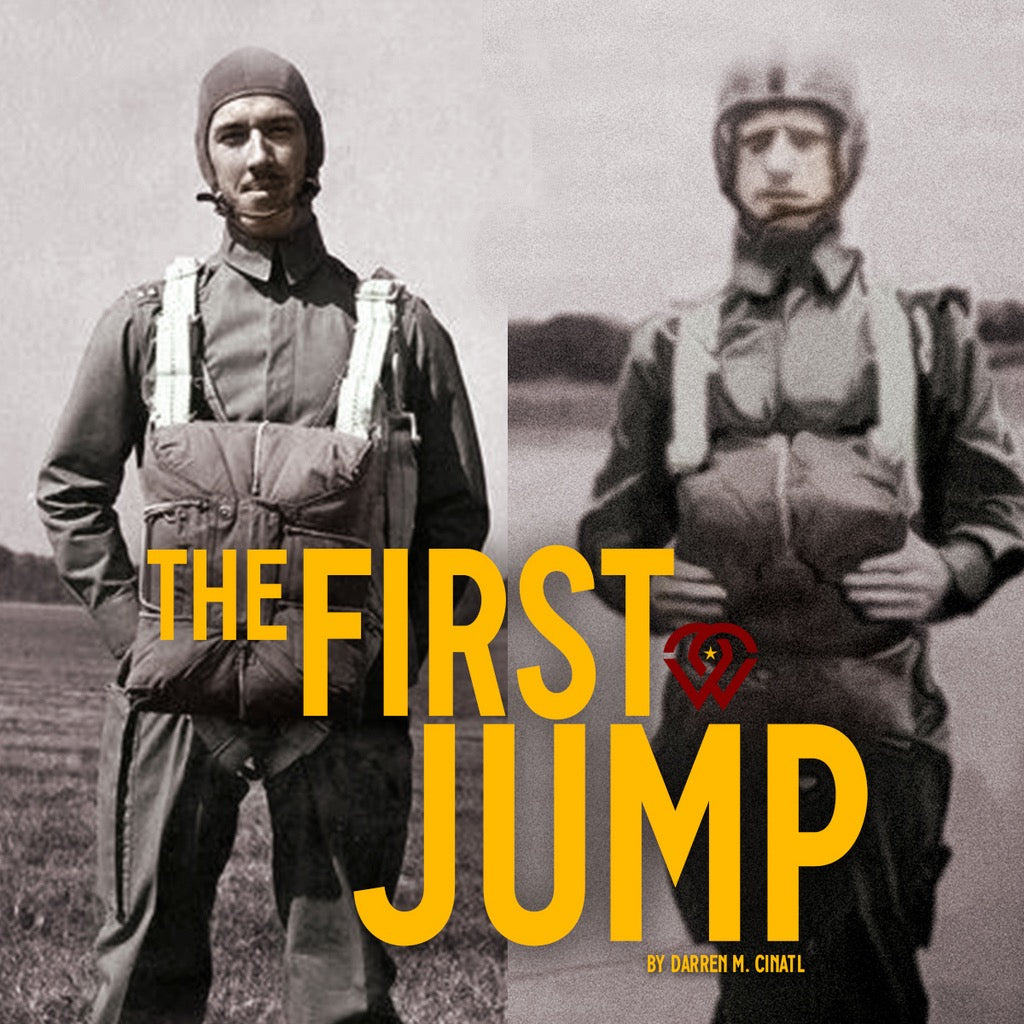
Forward: The American Paratrooper:
What does it mean to be a Paratrooper? Suffice it to say it goes beyond just earning the coveted Silver Wings. It is indeed a way of life. A mindset and a calling that has a proud history and storied tradition. A means of deterrence to those who seek to do us harm. It is the American Paratrooper who strikes fear into the hearts of our enemies, and keeps them awake at night with the thought of tenacious men and women descending from the sky, fighting, and winning against any foe foolish enough to challenge them. The history of the American Paratrooper dates back to WWI, when the new concept of vertical envelopment was proposed by BG William “Billy” Mitchell of the Army Air Corps. BG Mitchell devised a plan to drop a division of American Infantrymen behind German lines. The war ended before the plan could be executed, but it set the foundation for the American Airborne concept.
The Conceptual Approval:
In 1940 the U.S. War Department approved the formation of a Parachute "Test Platoon" under the direction and control of the Army's Infantry Branch. On 25 July, 1940, General George C. Marshall, Chief of Staff of the Army, authorized the War Department to immediately establish a Parachute Test Platoon to experiment with the development and employment of airborne troops. 1LT William T. Ryder, an officer who studied Russian and German airborne focused tactics while in school, along with fifteen other officers volunteered for the opportunity to lead the Platoon. When 1LT Ryder took the written exam, he realized most of the material was derived from articles he personally submitted to the Infantry Branch. In forty-five minutes, 1LT Ryder completed the proposed two hour examination and was quickly selected to lead the Parachute Test Platoon.
The Training:
Of the 200 Fort Benning soldiers that applied, only 48 enlisted men were selected to proceed with training. Another Commissioned Officer also was selected, 1LT James A. Basset, who was appointed as the Assistant Platoon leader for the element. Due to the danger of this new concept, married men and those with children were not allowed to apply. These 50men endured the rigorous entrance exam, 7 weeks of daunting training, hours of packing their own parachutes and the ultimate challenge of testing the unknown: being the first men to exit an aircraft while in flight. Five Army Air Corps’ Parachute Riggers, led by Warrant Officer Harry “Tug” Wilson, trained the Test Platoon. In the first two weeks, the Test Platoon went through tough physical training combined with classes on the history and theory of the aerial delivery by parachute. During week three, MAJ William C. Lee, the officer tasked with managing the development of airborne forces and who would later be dubbed the “father of the American Airborne,” sent the Platoon to Hightstown, New Jersey where there were two 150-foot parachute jump towers that were used in the New York City World’s Fair in 1939. The Platoon would in turn use these towers that were originally an amusement ride to hone their airborne skills. The 250-foot free towers on Fort Benning would later be modeled after these to facilitate in-house airborne training. The Platoon trained in New Jersey for ten days before returning to Fort Benning to finish their final two weeks of training. On the last day of week seven of the course, which consisted of more parachute packing, physical training and focus on actions in the aircraft, 1LT Ryder announced the Platoon would make five jumps the following week. Warrant Officer Wilson explained there would be a demonstration where a dummy would be dropped from an aircraft while in flight, and essentially proof the concept that the 48 men had arduously trained on. Upon exit, the dummy that the Platoon had nicknamed “Oscar,” plummeted to the ground and was destroyed. The men of the Test Platoon remained resolute, and prepared to make their first jump.
The First Jump: August 16th, 1940:
The Paratroopers of the Test Platoon held a lottery to determine which enlisted man would get to jump first. The soldier who drew the lucky number one slot was offered up to $50 to switch with the other members of the Platoon. At the time such an offer was an equivalent to two months pay. The number one enlisted jumper refused. The jumpers boarded Douglas B-18A “Bolo” bombers, and took off from Fort Benning’s Lawson Field. Chief Wilson became the Army’s first Jumpmaster as he prepared the Platoon to exit an aircraft in flight for their first time. 1LT Ryder, the leader of the Platoon, was the first one out of the lead aircraft, earning him the title of the “First American Paratrooper.” When it finally came time for the first enlisted man to do the same, the would-be Paratrooper instead became the first Jump Refusal. The next in the stick happened to be a young PVT William "Red" King. King, a Corporal who turned in his stripes so he could be in the Test Platoon. It was by this twist of fate that made PVT King the first American enlisted Paratrooper to exit an aircraft while in flight. The final and qualifying jump for the Test Platoon came August 29, 1940. The operation was observed by MAJ Lee, GEN Marshall, and Secretary of War Henry L. Stimson. The Platoon completed their first mass tactical operation with only one minor issue: one paratrooper landed on a hangar that the Platoon had used for packing parachutes. He was not injured, and the concept of vertical envelopment was proven a success. As a result, the U.S. Army moved forward with forming the first parachute battalion. On 16 September 1940 it was constituted as Company A, 501st Parachute Battalion and was officially activated at Fort Benning on October 1st, 1940. This battalion absorbed the Test Platoon’s members and would be used to help activate the 502nd Parachute Battalion, before being deployed to Panama to bolster defenses at Fort Kobbe. The 501st and 502nd led the way for the storied actions of the Airborne, and its members would be dispersed amongst the later formed units of the Airborne Divisions. The Airborne Division concept first touched on by BG Mitchell during WWI would later come into contention as the United States entered WWII. Then LTG Eisenhower asserted that airborne elements were best employed at the Regimental Combat Team level, where they were “self-contained units comprising of Infantry, Artillery and Special Services.” The 82nd and 101st Infantry Divisions were rebranded “Airborne Divisions” at Camp Claiborne, Louisiana in August of 1942; however, the Division concept would not be proven until after the first major airborne operation for the United States. On 08 November of 1942, the 2nd Battalion, 509th Parachute Infantry jumped into North Africa to serve as the spearhead for Operation Torch. Characterized by misdrops, and resulting in only 10 of the 39 C-47s actually exiting Paratroopers, the overall concept that was proven by the Test Platoon was now under extreme criticism.
The Division Concept:
The fate of the Airborne very well may have been decided just outside of Fort Bragg, North Carolina. In 1943, Operations Torch and Husky had already taken place, characterized by misdrops and friendly fire incidents that brought down aircraft and caused hundreds of casualties. Citing these failures, there would be a prominent push for the advent of the Pathfinder, but later shifted into the questioning of the theory of vertical envelopment as a whole. The man who approved the concept, Chief of Staff GEN Marshall did believe in the concept he approved in 1940, and disagreed with the Airborne’s employment in Regimental Combat Teams. Instead he called for an assessment of the feasibility of conducting vertical envelopment with Airborne Divisions. On 07 December 1943, at the Knollwood Auxiliary Army Airfield (now Moore County Airport outside Southern Pines, NC), hosted the largest demonstration yet. Around midnight 200 C-47s, many with gliders in tow took off from Army airfields at Pope Field, Camp Mackall, Lumberton, Laurinburg and even Florence, SC, and met over the Atlantic for an assault onto Knollwood Field. Over the next five days 10,282 Paratroopers and Glidermen were delivered to the ground. 1830 tons of supplies and over 295 jeeps were dropped or delivered to the ground via air land. It was one of the first Division on Division fights, with the BLUFOR: 11th Airborne Division and the 501st, fighting against the OPFOR: the 17th Airborne Division and 541st PIR. Another similar exercise was held in January 1944 prior to the invasion and airborne assault on the Cotentin on the Day of Days. The Parachute Test Platoon forged the airborne concepts that would later define the Airborne’s storied operations over the last century, and come to define how both the training and employment of our airborne forces would continue now 80 years after their first exit over the skies of Fort Benning.
National Airborne Day:
National Airborne Day was officially brought into being by President George W. Bush, who on 14 August 2002 declared that August 16th would forever be known as National Airborne Day. The day commemorates the first jump of the storied Parachute Test Platoon, and also falls near the anniversaries of the activation of the 82nd Airborne and 101st Airborne Divisions on 15 and 16 August 1942 respectively. This year marks the 80th Anniversary of the American Airborne, and it is important that we revisit the introduction of the Airborne Concept and how the Paratroopers of today have been molded by the experiences and bravery of those of the past. AATW!
What does it mean to be a Paratrooper? Suffice it to say it goes beyond just earning the coveted Silver Wings. It is indeed a way of life. A mindset and a calling that has a proud history and storied tradition. A means of deterrence to those who seek to do us harm. It is the American Paratrooper who strikes fear into the hearts of our enemies, and keeps them awake at night with the thought of tenacious men and women descending from the sky, fighting, and winning against any foe foolish enough to challenge them. The history of the American Paratrooper dates back to WWI, when the new concept of vertical envelopment was proposed by BG William “Billy” Mitchell of the Army Air Corps. BG Mitchell devised a plan to drop a division of American Infantrymen behind German lines. The war ended before the plan could be executed, but it set the foundation for the American Airborne concept.
The Conceptual Approval:
In 1940 the U.S. War Department approved the formation of a Parachute "Test Platoon" under the direction and control of the Army's Infantry Branch. On 25 July, 1940, General George C. Marshall, Chief of Staff of the Army, authorized the War Department to immediately establish a Parachute Test Platoon to experiment with the development and employment of airborne troops. 1LT William T. Ryder, an officer who studied Russian and German airborne focused tactics while in school, along with fifteen other officers volunteered for the opportunity to lead the Platoon. When 1LT Ryder took the written exam, he realized most of the material was derived from articles he personally submitted to the Infantry Branch. In forty-five minutes, 1LT Ryder completed the proposed two hour examination and was quickly selected to lead the Parachute Test Platoon.
The Training:
Of the 200 Fort Benning soldiers that applied, only 48 enlisted men were selected to proceed with training. Another Commissioned Officer also was selected, 1LT James A. Basset, who was appointed as the Assistant Platoon leader for the element. Due to the danger of this new concept, married men and those with children were not allowed to apply. These 50men endured the rigorous entrance exam, 7 weeks of daunting training, hours of packing their own parachutes and the ultimate challenge of testing the unknown: being the first men to exit an aircraft while in flight. Five Army Air Corps’ Parachute Riggers, led by Warrant Officer Harry “Tug” Wilson, trained the Test Platoon. In the first two weeks, the Test Platoon went through tough physical training combined with classes on the history and theory of the aerial delivery by parachute. During week three, MAJ William C. Lee, the officer tasked with managing the development of airborne forces and who would later be dubbed the “father of the American Airborne,” sent the Platoon to Hightstown, New Jersey where there were two 150-foot parachute jump towers that were used in the New York City World’s Fair in 1939. The Platoon would in turn use these towers that were originally an amusement ride to hone their airborne skills. The 250-foot free towers on Fort Benning would later be modeled after these to facilitate in-house airborne training. The Platoon trained in New Jersey for ten days before returning to Fort Benning to finish their final two weeks of training. On the last day of week seven of the course, which consisted of more parachute packing, physical training and focus on actions in the aircraft, 1LT Ryder announced the Platoon would make five jumps the following week. Warrant Officer Wilson explained there would be a demonstration where a dummy would be dropped from an aircraft while in flight, and essentially proof the concept that the 48 men had arduously trained on. Upon exit, the dummy that the Platoon had nicknamed “Oscar,” plummeted to the ground and was destroyed. The men of the Test Platoon remained resolute, and prepared to make their first jump.
The First Jump: August 16th, 1940:
The Paratroopers of the Test Platoon held a lottery to determine which enlisted man would get to jump first. The soldier who drew the lucky number one slot was offered up to $50 to switch with the other members of the Platoon. At the time such an offer was an equivalent to two months pay. The number one enlisted jumper refused. The jumpers boarded Douglas B-18A “Bolo” bombers, and took off from Fort Benning’s Lawson Field. Chief Wilson became the Army’s first Jumpmaster as he prepared the Platoon to exit an aircraft in flight for their first time. 1LT Ryder, the leader of the Platoon, was the first one out of the lead aircraft, earning him the title of the “First American Paratrooper.” When it finally came time for the first enlisted man to do the same, the would-be Paratrooper instead became the first Jump Refusal. The next in the stick happened to be a young PVT William "Red" King. King, a Corporal who turned in his stripes so he could be in the Test Platoon. It was by this twist of fate that made PVT King the first American enlisted Paratrooper to exit an aircraft while in flight. The final and qualifying jump for the Test Platoon came August 29, 1940. The operation was observed by MAJ Lee, GEN Marshall, and Secretary of War Henry L. Stimson. The Platoon completed their first mass tactical operation with only one minor issue: one paratrooper landed on a hangar that the Platoon had used for packing parachutes. He was not injured, and the concept of vertical envelopment was proven a success. As a result, the U.S. Army moved forward with forming the first parachute battalion. On 16 September 1940 it was constituted as Company A, 501st Parachute Battalion and was officially activated at Fort Benning on October 1st, 1940. This battalion absorbed the Test Platoon’s members and would be used to help activate the 502nd Parachute Battalion, before being deployed to Panama to bolster defenses at Fort Kobbe. The 501st and 502nd led the way for the storied actions of the Airborne, and its members would be dispersed amongst the later formed units of the Airborne Divisions. The Airborne Division concept first touched on by BG Mitchell during WWI would later come into contention as the United States entered WWII. Then LTG Eisenhower asserted that airborne elements were best employed at the Regimental Combat Team level, where they were “self-contained units comprising of Infantry, Artillery and Special Services.” The 82nd and 101st Infantry Divisions were rebranded “Airborne Divisions” at Camp Claiborne, Louisiana in August of 1942; however, the Division concept would not be proven until after the first major airborne operation for the United States. On 08 November of 1942, the 2nd Battalion, 509th Parachute Infantry jumped into North Africa to serve as the spearhead for Operation Torch. Characterized by misdrops, and resulting in only 10 of the 39 C-47s actually exiting Paratroopers, the overall concept that was proven by the Test Platoon was now under extreme criticism.
The Division Concept:
The fate of the Airborne very well may have been decided just outside of Fort Bragg, North Carolina. In 1943, Operations Torch and Husky had already taken place, characterized by misdrops and friendly fire incidents that brought down aircraft and caused hundreds of casualties. Citing these failures, there would be a prominent push for the advent of the Pathfinder, but later shifted into the questioning of the theory of vertical envelopment as a whole. The man who approved the concept, Chief of Staff GEN Marshall did believe in the concept he approved in 1940, and disagreed with the Airborne’s employment in Regimental Combat Teams. Instead he called for an assessment of the feasibility of conducting vertical envelopment with Airborne Divisions. On 07 December 1943, at the Knollwood Auxiliary Army Airfield (now Moore County Airport outside Southern Pines, NC), hosted the largest demonstration yet. Around midnight 200 C-47s, many with gliders in tow took off from Army airfields at Pope Field, Camp Mackall, Lumberton, Laurinburg and even Florence, SC, and met over the Atlantic for an assault onto Knollwood Field. Over the next five days 10,282 Paratroopers and Glidermen were delivered to the ground. 1830 tons of supplies and over 295 jeeps were dropped or delivered to the ground via air land. It was one of the first Division on Division fights, with the BLUFOR: 11th Airborne Division and the 501st, fighting against the OPFOR: the 17th Airborne Division and 541st PIR. Another similar exercise was held in January 1944 prior to the invasion and airborne assault on the Cotentin on the Day of Days. The Parachute Test Platoon forged the airborne concepts that would later define the Airborne’s storied operations over the last century, and come to define how both the training and employment of our airborne forces would continue now 80 years after their first exit over the skies of Fort Benning.
National Airborne Day:
National Airborne Day was officially brought into being by President George W. Bush, who on 14 August 2002 declared that August 16th would forever be known as National Airborne Day. The day commemorates the first jump of the storied Parachute Test Platoon, and also falls near the anniversaries of the activation of the 82nd Airborne and 101st Airborne Divisions on 15 and 16 August 1942 respectively. This year marks the 80th Anniversary of the American Airborne, and it is important that we revisit the introduction of the Airborne Concept and how the Paratroopers of today have been molded by the experiences and bravery of those of the past. AATW!

